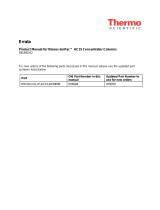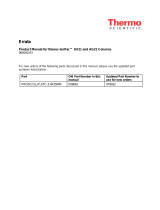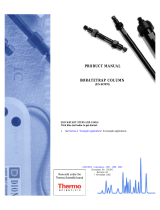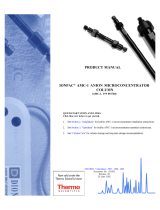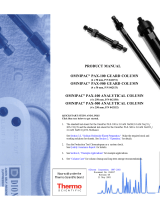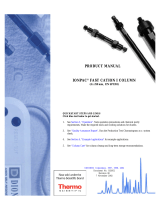Page is loading ...

ver.20221202E
Resonac Corporation (https://www.shodex.com/)
1
Operation Manual
Shodex IC NI-424
(Please read this operation manual carefully to achieve the best and consistent column performance for a long time.)
Important Handling Instructions
Caution! · Please consult the Safety Data Sheet (SDS) of reagents and solvents used with the column
and understand their proper handling methods to prevent potential health hazards or death
from occurring.
· Please wear appropriate personal protective equipment such as lab goggles and gloves
when handling organic solvents and acid and alkaline reagents. Avoid any direct physical
contact to prevent chemical injuries.
Before Using the Column
(1) Please visually inspect the column package and the column surface for any damage.
(2) Please check the product name and serial number (Serial no. or S/N) written on the column package and
adhesive label on the column body.
(3) Please download the Certificate of Analysis (CoA) for the purchased product. The CoA can be downloaded
from Shodex website (https://www.shodex.com/download/). You will be asked to enter the serial number.
1. Introduction
Thank you for purchasing the Shodex product. Shodex IC NI-424 is a non-suppressor type ion chromatography
column for anion analysis. It is suitable for separation and analysis of anions in environmental field.
2. Column Components
Please refer to the Shodex website: https://www.shodex.com/en/da/07.html
3. Column Specifications
Product
Code Product Name Column Size (mm) Particle Size
(μm)
Theoretical Plate Number
(Per Column)
I.D. Length
F6995243 IC NI-424 4.6 100 5 ≥ 5,000
F6709616
IC NI-G
4.6 10 5 (Guard Column)
4. Usable Conditions
Base Material
: Spherical porous particles of polyhydroxymethacrylate modified with quaternary ammonium
Column Housing
: SUS-316
Screw Type
: Internally-threaded type No.10-32 UNF
Shipping Solvent
: Aqueous Solution of 8 mM 4-Hydroxybenzoic Acid + 2.8 mM Bis-Tris*1 + 2 mM Phenylboronic
Acid + 0.005 mM CyDTA*2
*1 Bis(2-hydroxyethyl)imino-tris-
(hydroxymethyl) methane
*2
trans-1,2-Diaminocyclohexane-N,N,N',N'-tetraacetic acid
Product Name Flow Rate (mL/min) Maximum Pressure
(MPa/column)
pH
Range
Temperature (°C)
Recommended Maximum Recommended Range
IC NI-424 1.0 1.2 6.0
2 - 11 40 20 - 60
IC NI-G - - -

ver.20221202E
Resonac Corporation (https://www.shodex.com/)
2
Usable solvents are listed below.
(1) Acidic aqueous solutions such as 4-hydroxybenzoic acid, phthalic acid, salicylic acid can be used.
(2) The standard eluent is a mixture of 8-mM 4-hydroxybenzoic acid, 2.8-mM Bis-Tris, 2-mM phenylboronic acid
and 0.005-mM CyDTA solutions. Bis-Tris is added to adjust the pH. Phenylboronic acid improves the
separation of phosphate and fluoride ions. CyDTA removes negative influence caused by the metal ions
eluted from the HPLC system connecting parts. Refer to section 5. Eluent Preparation for how to prepare
the standard eluent.
(3) Elution timings and elution order of analytes can be modified by optimizing the eluent type, concentration,
pH, etc.
(4) Up to 10 % (v/v) acetonitrile or methanol can be added.
Attention! · Use the column within above stated flow rate, pressure, and temperature ranges. Using
the column outside the given range may damage the column and lower its performance.
· During high sensitive analysis, trace amounts of impurities in 4-hydroxybenzoic acid
reagent may appear as vacant peaks on the chromatogram and interfere with
measurement. In such cases, recrystallization of 4-hydroxybenzoic acid is recommended.
An example of recrystallization is below.
(1) Add 10 g of 4-hydroxybenzoic acid little by little while heating and stirring 500 mL of
water.
(2) When 4-hydroxybenzoic acid is completely dissolved and becomes transparent
(about 20 minutes) , leave it at room temperature overnight (Needle-shaped crystals
will appear).
(3) After filtering with filter paper (No.5A), wash the filter paper with 1 L of water.
(4) Heat the filtrate to 150 °C and dry (About 4 hours). *Melting point of 4-hydroxybenzoic
acid is 215 °C.
· For alkaline eluents with pH 7 or higher, it is recommended to attach a carbon dioxide gas
trap at the eluent container inlet. The pH of alkaline eluent tends to change due to
absorption of carbon dioxide gas. In general, it is recommended to use an acidic eluent
which has less pH change.
· Column pressure is influenced by the eluent composition, flow rate, and column
temperature. When changing the eluent compositions, adjust the flow rate and column
temperature so that the column pressure remains below the usable maximum pressure.
5. Eluent Preparation
(1) Standard eluent: Weigh and add 4-hydroxybenzoic acid (special grade) 1.105 g, Bis-Tris 0.586 g,
phenylboronic acid 0.244 g, and CyDTA 1.7 mg into a 1 L volumetric flask, and then add water to make 1 L.
Apply the volumetric flask to ultrasonic waves to completely dissolve the reagent.
(2) Degas the eluent fully to prevent the formation of air bubbles.
(3) Presence of small debris or insoluble substances may result in deterioration of columns and/or they may
appear as noise on chromatograms. Filter the eluent with a 0.45-μm disposable filter to prevent the problems
from occurring.
Attention! · Whenever water is required, use ultra-pure water freshly generated by a water purification
system or water from a newly opened HPLC grade distilled water bottle. Use of HPLC
grade organic solvents of guaranteed quality, which can be used without problems in HPLC
is recommended. If organic solvents with different grades are used together, make sure
that their qualities are all suitable for the analysis prior to the use. Solvents left in opened
bottles for a long time should not be used. The content may have been changed, absorbed
moisture, or has been contaminated.
· Always use freshly prepared solvents. Solvents stored for a long time may have changed
their compositions and may influence elution patterns and/or damage the column.
Note · Use of an on-line degasser is recommended.
6. Sample Preparation
(1) Filter diluted sample solutions using disposable 0.45-μm filters to prevent the column from clogging or
deteriorating.

ver.20221202E
Resonac Corporation (https://www.shodex.com/)
3
(2) Suggested injection volume is 10 - 100 μL per column.
(3) When a sample contains proteins, remove them prior to the sample injection. The use of an ultrafiltration
membrane is recommended.
(4) When a sample contains hydrophobic impurities, remove the impurities prior to the sample injection. The
use of a solid phase extraction is recommended.
Attention! · When a sample is dissolved in a solvent other than the eluent and if the sample matrix
contains components which do not dissolve in the eluent fully, precipitates may form and
clog the column.
· Full column performance may not be achieved if a sample concentration is higher or
sample injection volume is larger than it should be. It may lead to abnormal peak shapes,
poor separations, and/or low reproducibility. In such cases, please adjust the sample
concentration and/or the injection volume.
Note · Use of a guard column is recommended to protect the analytical column.
7. Column Usage Procedure
7.1 HPLC System Preparation
Wash the entire HPLC system prior to column installation, including all flow-lines and sample loop by switching
the valves, and then replace the washing solution with the eluent to be used. If desired new eluent has low
miscibility/solubility to the eluent of previous analysis, first use the eluent that is miscible/soluble to both eluents,
and then replace it with the desired eluent.
Attention! · If the eluent left in the HPLC system is not compatible with the column to be used, it may
damage the column.
· A drastic change in the eluent compositions may remove substances adsorbed on the
HPLC system and they may enter and deteriorate the column.
7.2 Column Installation
(1) Connect the column to HPLC system by following the “flow direction arrow” (➡) indicated on the column
adhesive label. If a guard column is used, position the guard column in front (before the inlet) of the analytical
column.
(2) Make sure to insert the tubing all the way to the end fitting and secure it with the male nut. It is important that
there is no extra space between the tubing and the column side of the end fitting. Presence of an extra space
will let the sample to spread out and may result in wide peaks.
(3) Set the initial flow rate at less than 0.5 mL/min and start the system. If the column is to be heated during the
analysis, keep the low flow rate until the column temperature reaches to the set temperature, and then
gradually increase the flow rate to the desired.
Caution! · Verify that there is no solvent leak. The solvent leak may cause electronic leakage, rust,
and/or chemical injury.
Attention! · Make sure not to let air bubbles enter the column while installing the column. The air
bubbles may damage the column.
· When restarting the system after column installation or after holding the eluent flow, start
the system at less than 0.5 mL/min flow rate. A rapid increase in pressure can damage the
column.

ver.20221202E
Resonac Corporation (https://www.shodex.com/)
4
· If the column was heated during the analysis, lower the flow rate to less than 0.5 mL/min
at the end of analysis. Then, turn off the column oven to let the column temperature returns
to room temperature before stopping the pump. This is to prevent creating an empty space
in the column, which deteriorates the column. Since if the pump was stopped while the
eluent inside the column is still hot, the eluent volume decreases and creates an empty
space when the eluent temperature decreases.
Note · It is recommended to set the pump limiter to avoid exceeding the maximum pressure.
7.3 Solvent Exchange
To replace the solvent, start the system at less than 0.5 mL/min flow rate. Recommended solvent volume to
introduce at each step is 3 to 5 times of the column volume.
Attention! · Frequent solvent replacement deteriorates the column, and thus not recommended.
7.4 Column Cleaning
Problems in peak shapes and elution time changes or elevated column pressure are often caused by the
deposition of insoluble or adsorbing components from the sample/flow-line inside the column. These problems
may be resolved by cleaning the column.
If a guard column is used with an analytical column(s), first remove the guard column and check the
performance of the analytical column alone. If the problem is solved, most likely the cause was from the guard
column. In this case, clean the guard column.
If the problem remains even after removing the guard column, clean both guard and analytical columns. Make
sure to clean the guard and the analytical columns separately. In case multiple number of analytical columns
are used together, wash them separately. During the column cleaning, disconnect the detector and collect the
washing solution directly from the column outlet into a waste container (i.e., do not let the solution go through
the detector).
If the column performance does not improve (recover) after performing the column cleaning, please
replace the column with a new one.
<Cleaning method>
(1) Insoluble components that block the column inlet may be removed by reversing the flow direction, i.e.,
introducing the eluent from the column outlet, with flow rate at less than half of the recommended flow rate.
(2) Follow the below for adsorbing components. For an efficient cleaning, reverse the flow direction.
Method 1: Adsorption of metal ions
Set the flow rate at 1.0 mL/min. Introduce 30 mL of 0.01-M aqueous tartaric acid solution (pH3 - 4
adjusted by 0.1-M hydroxide sodium).
Method 2: Adsorption of proteins
Set the flow rate at 0.2 mL/min. Introduce 30 mL of 20 % (v/v) aqueous acetic acid solution, and then
introduce 30 mL of water.
Method 3: Adsorption of organic compounds
Set the flow rate at 0.2 mL/min. Introduce 30 mL of acetonitrile/water = 10/90, and then introduce
30 mL of water.
Attention! · Keeping the washing solution in the column for a long time will lead to column deterioration.
Please replace thewashing solution with the eluent immediately after cleaning.
8. Column Storage
Remove the column from HPLC system after replacing the in-column solvent with the initial shipping solvent.
Securely tighten the end caps and store the column at a location with stable temperature (a cool and dark space
is recommended). Refer to section 7.3 Solvent Exchange for how to replace the eluent.
Attention! · Never allow inside the column to dry. It can damage the column.
9. Column Inspection
Please refer to the inspection method described in the CoA. At Shodex, “half width method” is adopted for the
calculation of plate count and “asymmetry factor (Fas)” is adopted for the calculation of peak symmetry. Please
refer to the Shodex website for the detail: https://www.shodex.com/en/da/07.html

ver.20221202E
Resonac Corporation (https://www.shodex.com/)
5
Attention! · Plate count and Fas values change significantly depend on samples and/or analysis
conditions being used. To check the initial column condition, please make sure to use the
same sample and the analysis condition mentioned in the CoA.
10. Additional Warnings
(1) Do not remove end fittings.
(2) Do not make a strong impact on the column. Do not drop or hit the column on a hard surface.
(3) Please follow a proper waste disposal method specified by your local regulations.
Please refer to the Shodex website (https://www.shodex.com/) for product details and their applications. For
additional assistance, contact the distributor from whom you purchased the column or contact your regional
Shodex support office (https://www.shodex.com/en/support_office/list).
/


